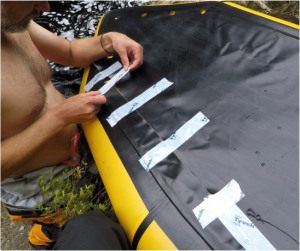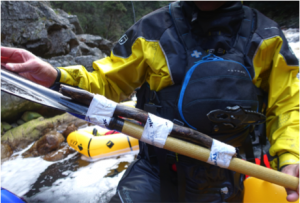 A big part of my job as an outdoor education teacher and instructor is to assess and pre-plan how I am going to minimize the potential risks. Plan for issues, hazards, equipment loss or gear failure by considering all the potential risks before the trip. Ask yourself lots of questions such as “Is it a fast flowing continuous river, are there large holes that are likely to flip or hold a boat, is it a steep creek where you are more likely to break a paddle?”
A big part of my job as an outdoor education teacher and instructor is to assess and pre-plan how I am going to minimize the potential risks. Plan for issues, hazards, equipment loss or gear failure by considering all the potential risks before the trip. Ask yourself lots of questions such as “Is it a fast flowing continuous river, are there large holes that are likely to flip or hold a boat, is it a steep creek where you are more likely to break a paddle?”
The answers do not necessarily mean you need to always carry lots of extra gear and excess weight for those ‘just in case’ situations but it does mean that you need to analyze the real risks of the environments you are travelling through. For some rivers this may simply involve carrying some Tyvek tape wrapped around your paddle shaft, whilst for other trips you may want to carry a more significant repair kit. See Alpacka’s excellent repair guide for a comprehensive idea on what to take and how to make in-field repairs.

On a pushy and steep rocky river it is not unreasonable to assume that at some stage someone in your
group may either lose or break a paddle. If the consequence of such are significant then plan for this eventuality. And actively discuss with the group pre-trip how you are going to deal with it. If exiting the trip is only feasible by travelling down river then I consider carrying hand paddle blades that weigh little and take up minimal space and which I can improvise a paddle out of. I have also a number of times simply tied two (and even three) packrafts together to make one large raft. As well as dealing with the loss of a paddle this technique can also be used to ferry an additional person downstream in order for them to be reunited with their boat. This set-up only requires one split-paddle, separated into two pieces. It is a technique worth trialing as this method works incredibly well for dealing with an awkward situation, even if it is only for a short distance.
Likewise do not presume that you will always be able to keep hold of your packraft in the event of a capsize. It is actually quite easy to lose a boat temporarily and there is always the chance you may lose your boat with all your camping gear for an extended period of time. See the video link within Tip #4 for a real-life example of this exact situation. In a small group situation on high flow, remote rivers, I personally recommend carrying a compact PLB or an inReach device inside your drysuit for dealing with this scenario. Similarly it’s not a bad idea to include some additional emergency survival items depending on the environment you are in. These may include items that give you the ability to light a fire, signal, navigate or provide energy.